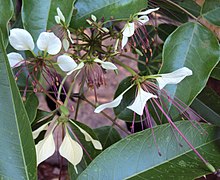Crateva magna
| Crateva magna | |
|---|---|

| |

| |
| Scientific classification | |
| Kingdom: | Plantae |
| Clade: | Tracheophytes |
| Clade: | Angiosperms |
| Clade: | Eudicots |
| Clade: | Rosids |
| Order: | Brassicales |
| Family: | Capparaceae |
| Genus: | Crateva |
| Species: | C. magna
|
| Binomial name | |
| Crateva magna (Lour.) DC
| |
| Synonyms | |
| |
Crateva magna is a small wild or cultivated tree native to India, China, Bangladesh, Sri Lanka, Burma,
and also in dry, deep boulder formations in Sub-Himalayan tracts.Uses
Medicinal uses
The dried bark is used as a raw drug in traditional systems of medicine in India, such as Ayurveda, siddha etc. A decoction of the bark is internally administered to cure diseases like renal calculi, dysuria, helminthiasis, inflammations and abscesses. The decoction has carminative, laxative, thermogenic, diuretic, lithontriptic, expectorant and demulcent actions.[4] The leaf and stem bark have been evaluated for their antioxidant activity and the inhibition of key enzymes relevant to hyperglycemia.[5]
Parts used
The dried bark and leaves are used for medicinal purposes.[6]
References
- ^ Mingli Zhang and Gordon C. Tucker (2008), "Crateva magna (Loureiro) Candolle, Prodr. 1: 243. 1824", Flora of China Online, vol. 7
- S2CID 8488022.
- ^ "Images and Information of Crataeva magna". Indian Medicinal Plants Database. Institute for Ayurveda and Integrative Medicine.
- .
- PMID 22196938.
- ^ http://www.tkdl.res.in/tkdl/langdefault/common/Home.asp?GL=Eng[full citation needed] Archived July 23, 2013, at the Wayback Machine
External links
 Data related to Crateva magna at Wikispecies
Data related to Crateva magna at Wikispecies Media related to Crateva magna at Wikimedia Commons
Media related to Crateva magna at Wikimedia Commons
